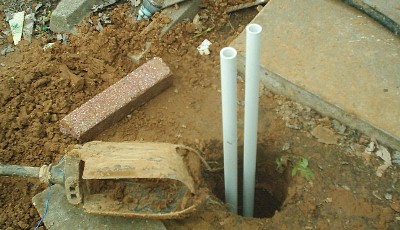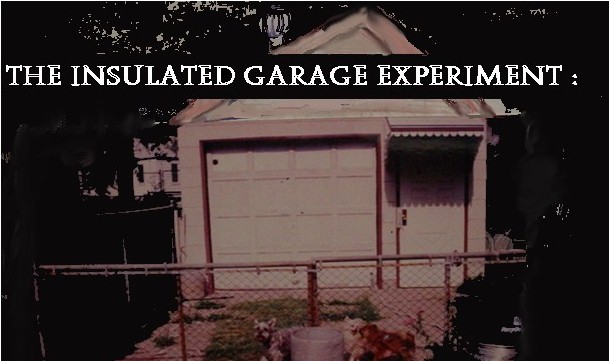
My plan to use UNDERGROUND coolness to cool a building started
when I insulated my garage workshop. When I started, I had a
building that i wanted to make easier to HEAT in the winter. But
I found an UNEXPECTED bonus. After adding an attic to the garage
and insulating all the walls with styrofoam, and the attic also
insulated, I noticed in the SUMMER the temperature of the building
had gone down from about 110 degrees before i started.... to about
85 degrees... without any airconditioning! I realized that the
coolness of the earth from the concrete floor was cooling the small
garage. I didn't expect this to happen. I had accidentally ALMOST
airconditioned the building in summer without using anything but
the coolness of the earth! And the coolness was only the SURFACE
coolness, not the REAL coolness located ten feet down of 60 degrees F.
I started getting curious about what the ACTUAL TEMPERATURES are
if you dig 3 feet down... or 6 feet or 10ft or 20 ft. I couldn't
find any graphs or data ANYWHERE. But EVERYONE always says, "yah, it
sure is COOL underground." Nobody could tell me EXACTLY what the
temperatures are though. So I decided to dig a big hole and measure
it for myself. Here are the RESULTS:
DEPTH Summer Winter
- Ft. 78 F. 28 F.
- Ft. 74 F. 32 F.
- Ft. 70 F. 34 F.
- Ft. 68 F. 38 F.
- Ft. 66 F. 40 F.
- Ft. 64 F. 42 F.
- Ft. 62 F. 44 F.
- Ft. 60 F. 46 F.
- Ft. 60 F. 48 F.
- F. 60 F. 52 F.
- F. 60 F. 54 F.
- F. 60 F. 58 F.
- Ft. 60 F. 60 F.
CAVE 56 F. 56 F.
The data might be off a little because temperatures were measured
different times of the year, using different thermometers... etc.
but it gives us a ballpark idea of how far down you have to go to
get real cool temperatures. The 56 degree reading I took when in
a cave called Meremec caverns in Missouri.
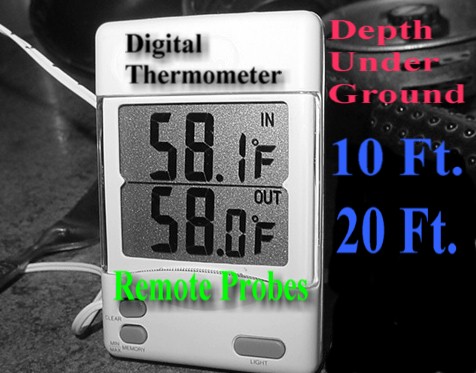
Here is a Dual Thermometer showing temperatures at the TEN foot level
and at the 20 foot depth. Readings taken at the beginning of summer.
So I was convinced UNDERGROUND COOLING could work. But HOW to get the
coolness up above-ground and IN the HOUSE?? One of the FIRST problems
to overcome, is HOW TO DIG the hole without spending LOTS of money to pay
well-drillers, or LOTS of work HAND-DIGGING with a shovel. One method I tried
was a WATER-INJECTOR drill made out of GASPIPE and attached to an electric
drill.......as pictured here :
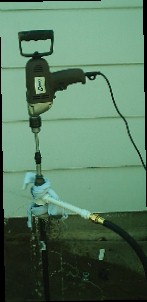
This drill took me WEEKS to design and build.... and it drilled a 2 inch wide
hole about ONE FOOT down when the electric drill BOGGED DOWN and stopped !
Another method had to be found. So I tried something an OLD MAN had told me
about... HE said, "use a TEE-handled hand-powered drill. They are easy to
use and just ADD lengths of half-inch-gaspipe to get down as far as you want."
So I tried it and IT WORKED!
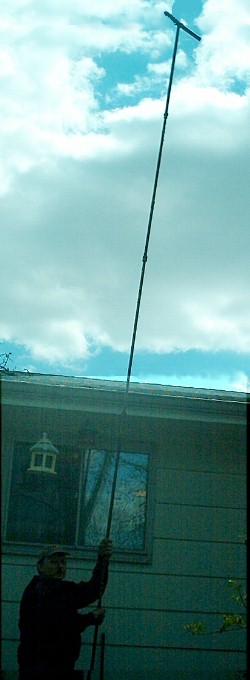
As you can see, I was able to use this drill method to drill down about
20 feet in about 6 hours of drilling. I was sure to check for OVERHEAD POWER
LINES first before doing this though. And I kept my small dog AWAY from the
hole untill it was done. Keep in mind the dangers of working on such a project
as this because If you decide to undertake this project, YOU are the only one
responsible for accidents not me.
During my many YEARS of working on this
system, I discovered an interesting thing about HOT WATER that i don't believe
most people are aware of. Everyone knows that HOT AIR RISES, and COLD AIR
FALLS DOWN, RIGHT? But did you know that HOT WATER RISES ALSO? I did
an experiment using a 5 foot long pvc pipe with a cap on the bottom. I filled
up the pipe with hot water and placed my temperature probe down the pipe.
here are my results:
60 inch level........(top) temperature is 120 deg F.
40 inch level........ temperature is 114 deg F.
20 inch level........ temperature is 104 deg F.
00 inch level........ (bottom) temperature 95 degrees F. !!
I did ANOTHER experiment where i placed some cold water in an OLD glass
coffeepot. then using a little squirt bottle, i squirted some COLORED water
into the BOTTOM INSIDE of the coffeepot. When I held a candle under the
coffeepot, I could SEE the colorwater RISING up.... proving again that
HOT WATER RISES. Some of you may say "SO WHAT." but think about it!
If you drill a pipe STRAIGHT DOWN into the ground to use as a radiator
of heat I believe the heat will RISE UP alongside the pipe that you are
trying to COOL!!! Therefore, I believe the best method of drilling a
heat exchanger into the ground is at an ANGLE... NOT straight down!
Horizontal pipes would work too... if you can get them DEEP ENOUGH where
the real coolness is.
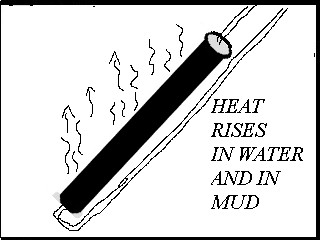
Another discovery I have made is that CIRCULATING WATER is easy to do.
you don't need a giant 200 watt waterpump. A little 4-watt 66 gallon
per hour $10.00 pump will do it! this is because water circulated does
not have to be LIFTED out of the ground like in a WELL. In a WELL, the
water must be LIFTED a couple hundred feet. That takes a HEFTY PUMP that
uses a lot of electricity. Here is a picture of my UNDERGROUND radiator
going into the 20ft. hole.

Like I said at the beginning, this system is a PROTOTYPE. I don't claim
it is working yet. Here is my radiator i built, but didn't get much
cooling from it. I do believe this system will eventually work, but
may need some input and suggestions from everyone interested.

My wife doesn't think much of my ideas. But I know YOU GUYS wont horse
laugh me too much. Right? Well its LATE... I wanted to make this more
detailed, but its enough to give you-all something to think and comment
about. I may add more later but this is about 90percent of it.
